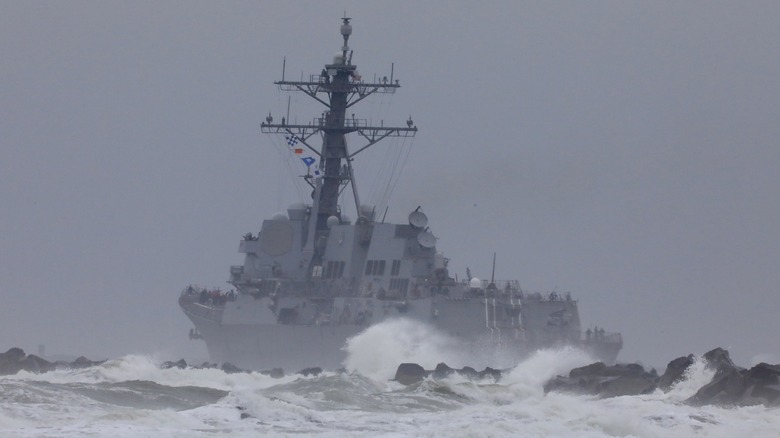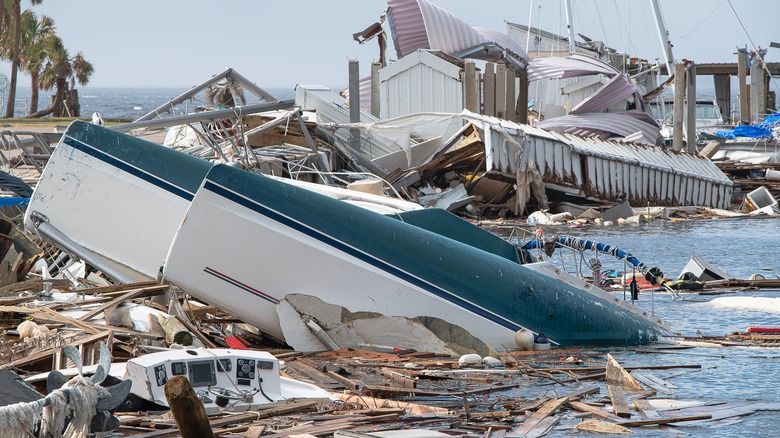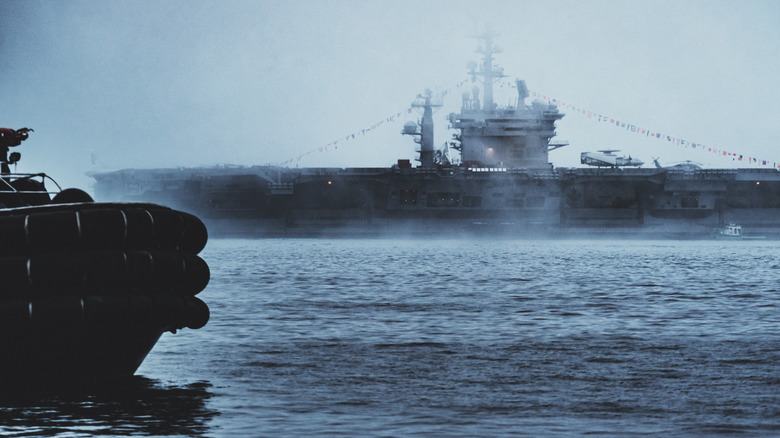Why Navy Ships Go Out To Sea In A Hurricane
When a storm hits at sea, the natural response for shipping is to head for the safety of a harbor or a sheltered shore. Unless it's a US Navy ship, that is. When a storm with the ferocity of a hurricane strikes, it isn't uncommon for ships that are seemingly tucked safely away in naval harbors or docks to shed their mooring lines and head out of port to face the storm head-on. However, this isn't a random act of bravado, or a training exercise designed to sort out the brave and the bold. Rather, it's a deliberate tactic designed to safeguard the ships against the worst that Mother Nature can throw at them.
While this might seem counterintuitive, there is sound logic behind it — logic that is grounded in experience and hard-learned lessons. Staying in port can actually increase the risk of damage, both to the ship and its surroundings. By heading out to sea, Navy vessels can maneuver more freely, avoid dangerous collisions, and ride out the storm in conditions they were built to handle. In short, this isn't an exercise that involves taking unnecessary risks, it's about reducing them. Additionally, warming oceans have increased the intensity of hurricanes, a side-effect of this is that hurricanes pull in more heat energy and water vapor. This results in stronger winds and increased rainfall when the hurricane makes landfall, meaning ships are often safer at sea. It is their natural habitat after all.
Why ships are safer at sea than in port
A navy ship comes alive when it's at sea. Free of the shackles of the land, it can meet an oncoming storm on its own terms. Hurricane Florence in 2018 is a prime example of this in action. As the storm ripped towards the Eastern seaboard, a convoy of 30 ships left navy ports and headed out to sea in what is known as a "sortie order." This included ships from Naval Station Norfolk, the largest naval base in the world and a noteworthy entry on SlashGear's list of the biggest US military bases.
At the time, Rear Admiral John Meier — now retired, but at the time was commander of a carrier strike group — said, "A sortie order is just that it's a precautionary order to set our ships to sea where we have much more ability to maneuver and avoid the storm. if you leave ships in port, there is always the hazard that a ship can be damaged, broken loose from its mooring lines or that our piers and infrastructure can be damaged as well."
Additionally, improved forecasting, satellite imagery, better communications, and continual improvements in hurricane tracking technology all reduce the risks to ships to at sea. This vulnerability of docked ships is why the navy sends its ships to sea in the face of oncoming storms. A sortie is a calculated move designed to protect billions of dollars of assets and the brave souls that crew them.
Hurricanes don't surprise the Navy
The US Navy isn't the type of organization to leave anything to chance, and certainly won't be caught off guard by some inclement weather. Not only do navy ships undergo extensive seaworthiness tests, but hurricane planning starts long before any storm is named. An important part of this preparation is the "sortie condition" system. A naval sortie isn't something that is decided on a whim, there is an established system that involves three sortie conditions. The first is Sortie Condition Charlie, when ships are ordered to this condition it means they can expect to leave port within 48 hrs as a result of heavy weather. Sortie Condition Bravo reduces the expected time to 24 hrs, and Sortie Condition Alpha means they must move quickly.
However, there are usually ships that can't make the sortie. For instance, a ship can be sidelined because of maintenance or repairs and be unable to leave the harbor. While they don't have the freedom of their sea-borne sister ships, they still take whatever precautions they can to lessen the risk. This includes outfitting the ships with extra mooring lines, dropping their anchors, and disconnecting from shore-based power supplies. This is all part of a system that is designed to keep the fleet safe and ready to take on whatever challenges it faces — even in the most extreme weather.


